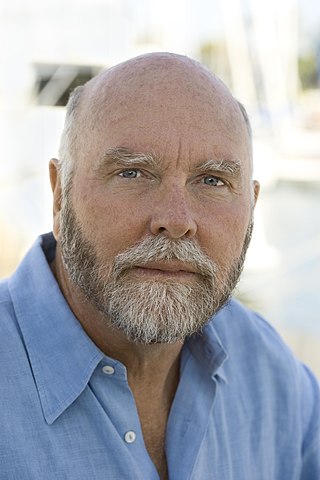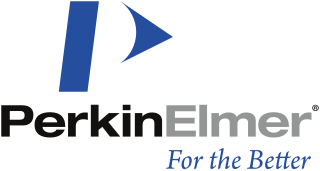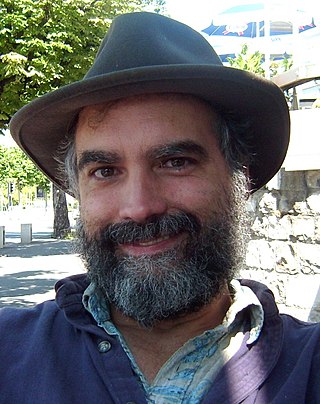Related Research Articles

John Craig Venter is an American biotechnologist and businessman. He is known for leading one of the first draft sequences of the human genome and assembled the first team to transfect a cell with a synthetic chromosome. Venter founded Celera Genomics, the Institute for Genomic Research (TIGR) and the J. Craig Venter Institute (JCVI). He was the co-founder of Human Longevity Inc. and Synthetic Genomics. He was listed on Time magazine's 2007 and 2008 Time 100 list of the most influential people in the world. In 2010, the British magazine New Statesman listed Craig Venter at 14th in the list of "The World's 50 Most Influential Figures 2010". In 2012, Venter was honored with Dan David Prize for his contribution to genome research. He was elected to the American Philosophical Society in 2013. He is a member of the USA Science and Engineering Festival's advisory board.

Celera is a subsidiary of Quest Diagnostics which focuses on genetic sequencing and related technologies. It was founded in 1998 as a business unit of Applera, spun off into an independent company in 2008, and finally acquired by Quest Diagnostics in 2011.

Leroy "Lee" Edward Hood is an American biologist who has served on the faculties at the California Institute of Technology (Caltech) and the University of Washington. Hood has developed ground-breaking scientific instruments which made possible major advances in the biological sciences and the medical sciences. These include the first gas phase protein sequencer (1982), for determining the sequence of amino acids in a given protein; a DNA synthesizer (1983), to synthesize short sections of DNA; a peptide synthesizer (1984), to combine amino acids into longer peptides and short proteins; the first automated DNA sequencer (1986), to identify the order of nucleotides in DNA; ink-jet oligonucleotide technology for synthesizing DNA and nanostring technology for analyzing single molecules of DNA and RNA.
Affymetrix is now Applied Biosystems, a brand of DNA microarray products sold by Thermo Fisher Scientific that originated with an American biotechnology research and development and manufacturing company of the same name. The Santa Clara, California-based Affymetrix, Inc. now a part of Thermo Fisher Scientific was co-founded by Alex Zaffaroni and Stephen Fodor. Stephen Fodor and his group, based on their earlier development of methods to fabricate DNA microarrays using semiconductor manufacturing techniques.

Human Genome Sciences (HGS) was a biopharmaceutical corporation founded in 1992 by Craig Venter, Alan Walton and Wally Steinberg. It uses the human DNA sequence to develop protein and antibody drugs. It had drugs under development to treat such diseases as hepatitis C, systemic lupus erythmatosis, anthrax, and cancer. It collaborated with other biotechnology and pharmaceutical companies for development partnerships and licensing.

PerkinElmer, Inc., previously styled Perkin-Elmer, is an American global corporation that was founded in 1937 and originally focused on precision optics. Over the years it went into and out of several different businesses via acquisitions and divestitures; these included defense products, semiconductors, computer systems, and others. By the 21st century, PerkinElmer was focused in the business areas of diagnostics, life science research, food, environmental and industrial testing. Its capabilities include detection, imaging, informatics, and service. It produced analytical instruments, genetic testing and diagnostic tools, medical imaging components, software, instruments, and consumables for multiple end markets. PerkinElmer was part of the S&P 500 Index and operated in 190 countries.
In September 2021, Synthetic Genomics Inc. (SGI), a private company located in La Jolla, California, changed its name to Viridos. The company is focused on the field of synthetic biology, especially harnessing photosynthesis with micro algae to create alternatives to fossil fuels. Viridos designs and builds biological systems to address global sustainability problems.

William James Kent is an American research scientist and computer programmer. He has been a contributor to genome database projects and the 2003 winner of the Benjamin Franklin Award.
The Baskin School of Engineering, known simply as Baskin Engineering, is the school of engineering at the University of California, Santa Cruz. It consists of six departments: Applied Mathematics, Biomolecular Engineering, Computational Media, Computer Science and Engineering, Electrical and Computer Engineering, and Statistics.
Tracking stock, also known as letter stock and targeted stock, is a specialized equity offering issued by a company that is based on the operations of a defined business within the larger organization. Therefore, the tracking stock will be traded at a price related to the operations of the specific division of the company being "tracked". Tracking stock is typically limited, or has no voting rights. Often, tracking stock is issued to separate a high-growth division from its parent company, while the parent company and its shareholders remain in control of the subsidiary's operations.

The Human Genome Project (HGP) was an international scientific research project with the goal of determining the base pairs that make up human DNA, and of identifying, mapping and sequencing all of the genes of the human genome from both a physical and a functional standpoint. It started in 1990 and was completed in 2006. It remains the world's largest collaborative biological project. Planning for the project started after it was adopted in 1984 by the US government, and it officially launched in 1990. It was declared complete on April 14, 2003, and included about 92% of the genome. Level "complete genome" was achieved in May 2021, with a remaining only 0.3% bases covered by potential issues. The final gapless assembly was finished in January 2022.
Applied Biosystems is one of various brands under the Life Technologies brand of Thermo Fisher Scientific corporation. The brand is focused on integrated systems for genetic analysis, which include computerized machines and the consumables used within them.
IMAGE cDNA clones are a collection of DNA vectors containing cDNAs from various organisms including human, mouse, rat, non-human primates, zebrafish, pufferfish, Xenopus (frogs), and cow. Together they represent a more or less complete set of expressed genes from these organisms. IMAGE stands for integrated molecular analysis of genomes and their expression.
Nuvelo Inc. was a biopharmaceutical company engaged in the discovery, development and commercialization of drugs for acute cardiovascular disease, cancer and other debilitating medical conditions. On January 27, 2009, the company was acquired by ARCA Biopharma, Inc. in a reverse takeover transaction.

Life Technologies Corporation was a biotech company founded in November 2008 through a US $6.7 billion merger of Invitrogen Corporation and Applied Biosystems Inc. The joint sales of the combined companies were about $3.5 billion; they had about 9,500 employees and owned more than 3,600 licenses and patents.

Linda Avey is an American biologist and entrepreneur. She is known for co-founding 23andMe, a consumer genetic data company.
Integromics was a global bioinformatics company headquartered in Granada, Spain and Madrid. The company had subsidiaries in the United States and United Kingdom, and distributors in 10 countries. Integromics specialised in bioinformatics software for data management and data analysis in genomics and proteomics. The company provided a line of products that serve gene expression, sequencing, and proteomics markets. Customers include genomic research centers, pharmaceutical companies, academic institutions, clinical research organizations, and biotechnology companies.
Human Longevity, Inc. is a San Diego-based venture launched by Craig Venter and Peter Diamandis in 2013. Its goal is to build the world's most comprehensive database on human genotypes and phenotypes, and then subject it to machine learning so that it can help develop new ways to fight diseases associated with aging. The company received US$80 million in investments in its Series A offering in summer 2014 and announced a further $220 million Series B investment offering in April 2016. It has made deals with drug companies Celgene and AstraZeneca to collaborate in its research.
Genomic Health, Inc. was a company focusing on genetic research specifically in cancer detection, based out of Redwood City, California. The company was acquired by and merged with Exact Sciences Corporation in 2019.
DNA: The Story of Life is a four-part Channel 4 documentary series on the discovery of DNA, broadcast in 2003.
References
- 1 2 3 4 5 6 APPLERA CORP Form:8-K sec.gov Filing Date: 11/28/2000
- 1 2 3 4 5 6 APPLERA CORP Form:8-K PDF SECDatabase, Accession Number: 0001110538-00-000004, Filing Date: November 28, 2000
- ↑ Directors and Officers, Board of Directors, SECDatabase, PE Corporation Annual Report - PDF, Filing Date: September 28, 1999
- 1 2 3 4 5 Sequencer of Genome to Change Focus, New York Times, By ANDREW POLLACK, Published: April 22, 2002
- 1 2 Standard & Poor's Stock Guide, various issues
- 1 2 3 4 5 READING THE BOOK OF LIFE, Double Landmarks for Watson: Helix and Genome, The New York Times on the Web, By NICHOLAS WADE, June 27, 2000
- 1 2 3 4 5 6 7 8 9 10 Human genome race tweaked by Celera's stock offer, Forbes.com, April 29, 1999
- 1 2 3 Corporate Officers, PE Corporation, 1999 Annual Report, Accession Number: 0001086144-99-000067, Period of Report: June 30, 1999
- 1 2 3 4 5 6 7 8 9 10 11 12 Applied Biosystems Timeline [ permanent dead link ]
- 1 2 3 4 Practitioners, NOUBAR B. AFEYAN, Ph.D., Senior Lecturer Archived June 4, 2007, at the Wayback Machine , MIT Entrepreneurship Center
- 1 2 3 4 5 6 PE Biosystems Chosen to Supply DNA Sequencers to Public Human Genome Project., Encyclopedia.com, From: Business Wire, press release, Date: 4/29/1999
- 1 2 Applera Corp SEC Form S-4/A, secinfo.com Filed On 3/19/99, SEC File 333-67797, Accession Number 1047469-99-10576
- 1 2 How can we enable new exploration? a letter from michael hunkapiller, ph.d., president, PE Biosystems Archived September 28, 2007, at the Wayback Machine , PE Corporation, 1999 Annual Report
- ↑ SEC Info - Petrokazakhstan Inc - 6-K - For 10/14/03, secinfo.com, October 14, 2003. On June 2, 2003, the PKN ticker symbol was briefly taken over by a small foreign issue, PetroKazakhstan Inc., which changed from HHL to PKN. On October 14, 2003, PetroKazakhstan Inc. filed with the SEC that it would again change its ticker symbol, to PKZ effective October 16, 2003, listed on the LSE, TSX and the NYSE exchanges, in London, Toronto and New York. PetroKazakhstan Inc. was subsequently acquired by a private company on October 26, 2005.
- 1 2 3 Notes to summary of financial statements, PE Corporation 1999 Annual Report
- ↑ What is the logic of biology? a letter from tony white to our shareholders Archived September 7, 2009, at the Wayback Machine , PE Corporation, 1999 Annual Report, CEO letter
- 1 2 COMPANY NEWS; PERKIN-ELMER CUTS 12% OF WORK FORCE, New York Times, Published: July 15, 1999
- ↑ The Slow, Painful Path to Payday in Genomic Stocks Archived August 7, 2007, at the Wayback Machine , Businessweek Online, By David Shook in New York, JUNE 12, 2000 ISSUE